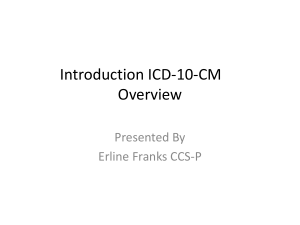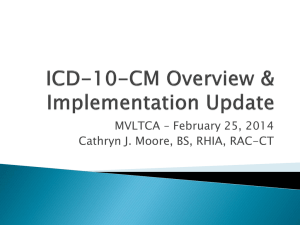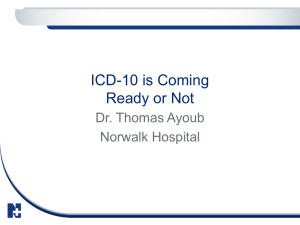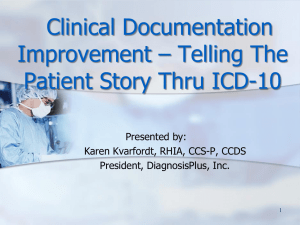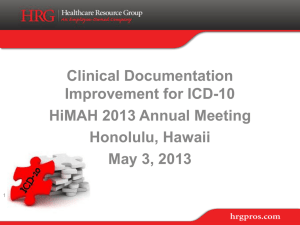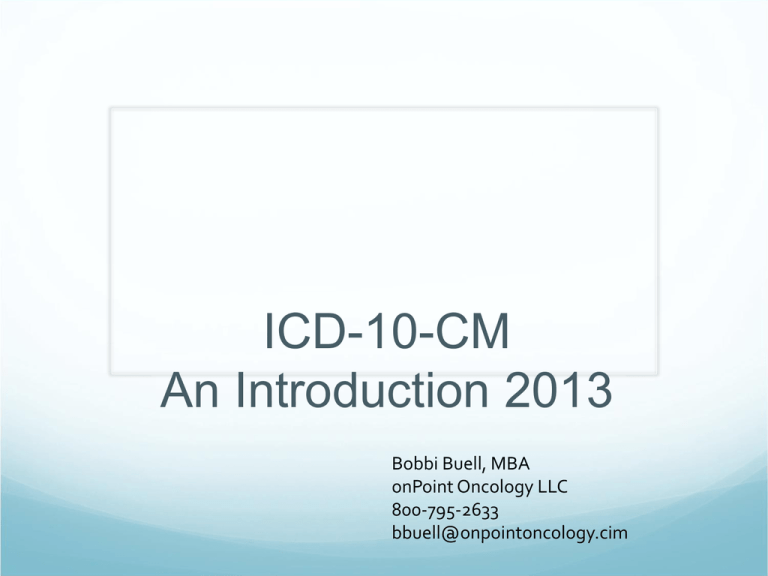
ICD-10-CM
An Introduction 2013
Bobbi Buell, MBA
onPoint Oncology LLC
800-795-2633
bbuell@onpointoncology.cim
Inspire panic---this is not that far away.
Create an awareness of ICD-10-CM.
Start to consider the impact the
conversion to ICD-10 will have on your
operations.
Start to understand what it means and
does not mean in Oncology.
Latest Update
This is happening 10/1/2014
CMS intimated that the deadline would not be
postponed.
The AMA still vehemently opposes this deadline.
Hospitals have spent millions on it.
You be the judge.
Implications of the Transition
– Who?
Providers
Hospitals
Physicians
Outpatient facilities
Post-acute providers (home health agencies, skilled
nursing facilities, etc.)
Health Plans or Payers
Third party administrators
Employers
4
Implications of the Transition
– Who?
Others
Laboratories
Free standing ancillaries
Researchers
Public health agencies et al
Data collection agencies/organizations (tumor registries)
Vendors
Clearinghouses
Business associates and partners
Patients
5
ICD-9-CM vs. ICD-10-CM
1) ICD-9-CM is out of date and running out of space
for new codes on the procedural side.
•
•
Lacks specificity and detail
No longer reflects current medical practice
2) ICD-10 is the international standard to report and
monitor diseases and mortality, making it important
for the U.S. to adopt ICD-10 based classifications
for reporting and surveillance.
3) ICD codes are the core elements of HIT systems,
conversion to ICD-10 is necessary to fully realize
benefits of HIT adoption.
Reimbursement Issues With ICD-9?
Example: Fracture of Wrist
Skateboarder fractures right wrist
A month later, fractures left wrist
ICD-9 would require additional documentation to find out
which wrist was fractured
ICD-10-CM describes in fracture codes
Left versus right
Initial or subsequent encounter
Routine healing , delayed healing, nonunion or malunion
There Are Benefits of ICD-10
Reflects more emerging technologies, particularly PCS
Captures the details of EMRs
Might reduce ADRs from payers due to more specificity
Statistical outcomes will be more measurable and
specific
May support better epidemiological trending
What is ICD-10-CM?
CM = Clinical modification to ICD-10 used around the
world
Consultation with
Physician groups
Clinical coders
Other users of ICD-9-CM
Who Runs The Show?
National Center for Health Statistics (NCHS) is the
federal agency that is responsible for maintaining the
diagnostic coding systems in the U.S.
CMS partners with them to oversee publicly available
coding systems
WHO oversees ICD-10 without the –CM
The American Health Information Management
Association (AHIMA) oversees education and training
ICD-10-CM code book retains the same
traditional format
Index
Tabular
Process of coding is similar
Look up a condition in the Index
Confirm the code in the Tabular
ICD – 9-CM
ICD – 10-CM
13,600 codes
69,000 codes
Code book contains 17 chapters
Code book contains 21 chapters
Consists of 3 to 5 characters
Consists of 3 to 7 characters
1st character is alpha or numeric
1st character is alpha
Only utilizes letters E and V
Utilizes all letters (except U)
Second, third, fourth, and fifth
characters are always numeric
Second character
is always numeric
Third, fourth, fifth, sixth, and seventh
characters can be alpha or numeric
Shorter code descriptions because
of lack of specificity and
abbreviated code titles
Longer code descriptions because of
greater clinical detail and specificity
and full code titles
Character Changes
ICD-9-CM
ICD-9-CM
Chapter
ICD-10-CM
ICD-10-CM
Chapter
001-139
Chapter 1
Infectious or
Parasitic Disease
A0-B99
140-239
Chapter 1
Neoplasms
C00-D49
320-389
Chapter 6
Diseases of the
Nervous System
G00-G99
Chapter 7
Diseases of the
Eye and Adnexa
H00-H59
Chapter 8
Diseases of the
Ear and Mastoid
H60-H95
ICD-9-CM CODE
ICD-10-CM CODE
A - Category of code
A - Category of code
B - Etiology,
B - Etiology,
anatomical site, and
manifestation
anatomical site,
and/or severity
C - Extension
7th character for obstetrics,
injuries, and external causes of
injury
A
B
A
B
C
ICD-9-CM Structure – Format
Numeric or
Alpha
(E or V)
V
X
E
5
4
Numeric
X
1
X
4
Category
.
X
0
X
0
Etiology, Anatomic
Site, Manifestation
3 – 5 Characters
ICD-10-CM Structure – Format
Alpha
(Except U)
M
X
A
S X
3 X
2
Category
2 - 7 Numeric or Alpha
.
Additional
Characters
X
0 X
1 X
0
A
X
Etiology, Anatomic
Site, Severity
Added code extensions
(7th character) for
obstetrics, injuries, and
external causes of injury
3 – 7 Characters
Characteristics of ICD-10-CM
ICD-10-CM far exceeds its predecessors in the number
of concepts and codes provided
The disease classification has been greatly expanded
to include health-related conditions and to provide
greater specificity at the sixth digit level and with the
seventh digit extension
By the way, the 6th and 7th digit extensions ARE NOT
optional for the codes where they are present
Arrangement of Volumes of
ICD-10
Volume 1: Main classifications
Volume 2: Instruction/ Guidance to users
Volume 3: Alphabetical Index
ICD-10 has 21 chapters against 17 Chapters in ICD-9
Chapters of ICD-10
Chapters I to XVII: Diseases and other morbid
conditions
Chapter XVIII: Symptoms, signs and abnormal
clinical and laboratory findings, not elsewhere
classified.
Chapter XIX: Injuries, poisoning and certain
other consequences of external causes.
Chapter XX: External causes of morbidity and
mortality,
Chapter XXI: Factors influencing health status
and contact with health services.
What You Should Worry About
The codes you most frequently use
Can you run a report from your PM or EMR system that
shows you all ICD-9’s that you have billed more than 50100 times over the past 2-3 years? Your limits will depend
upon your size.
These are the codes you need to know and translate.
You do not need to know 69,000 codes
But, physicians need to access to non-cancer codes to
use when they are evaluating and/or managing patients
General Equivalence
Mappings
Forward Mapping
ICD-9
Code
820.8
Description
(Source)
ICD-10
Code
Fracture of unspecified part of
neck of femur, closed
S72.009A
Description
(Target)
Fracture of unspecified part of
neck of femur, initial encounter
for closed fracture
Backward Mapping
ICD-9
Code
820.8
Description
(Target)
Fracture of unspecified part of
neck of femur, closed
ICD-10
Code
S72.001
A
Description
(Source)
Fracture of unspecified part of
neck of right femur, initial
encounter for closed fracture
S72.002
A
Fracture of unspecified part of
neck of left femur, initial
encounter for closed fracture
S72.009
Fracture of unspecified part of
neck of femur, initial encounter
for closed fracture
GEMS Example #1
GEMS Example #2
GEMS #3
GEMS Example #4
Other Major Differences With
ICD-10
Use additional codes
Sequelae
Combination codes
Differences in anemia
Mandatory 6th and 7th digits
Cancer Differences
Laterality
Mandatory’ use additional’ codes—look at lung cancer
6th digits (check out skin and breast cancers)
Much more detail and confusion surrounding
lymphoma
More detail in myeloid leukemia
Help with CUP
And this must be
documented….
Preparing for ICD-10
Checklist: http://www.ahima.org/icd10/ICD-10PreparationChecklist.mht
Year
Phase I
Phase II
Phase III
Phase IV
32
2011
2012
2013
2014
Awareness and
Impact Assessment
Preparing for
Implementation
Go Live
Preparation
Post –
Implementation
Where to Start?
Diagnostic Codes are
Ubiquitous
Diagnostic codes are everywhere – used by every
person, every process, every system….
– Superbills
– Payments/EOBs/ERAs
– Referrals
– Contracts
– EMRs
But, again, this is limited to codes you actually use
34
Solo Practitioner Or Small Group (2-10)
Practice Implementation Planning
1. Organize Implementation Effort
2. Establish Communication Plan
3. Conduct Impact Analysis
4. Contact System Vendors
5. Estimate Budget
6. Implementation Planning
7. Develop Training Plan
8. Analyze Business Processes
9. Education and Training
10. Policy Change Development
11. Deployment of Code
12. Implementation Compliance
Source: AAPC
35
2013 Plan
Organize Implementation Effort
Enlist staff person (coder, biller, manager) to oversee
effort who will be key point person
― Prepare information to share with other providers and staff
― Identify work and scope for implementation
Should be a team effort involving all medical practice staff
and the staff needs to believe that this will actually
happen.
If everyone is not signed on to this, your effort will not
work long term
37
Organize Implementation Effort
Examine the level of coding you have in your practice—who is
certified? Who has experienced a change before, e.g. E/M, admin
codes? Who is equipped to deal with this?
Look at all areas that will impact practice and identify each one that
will be affected
― List of codes
― Practice management system
― Electronic Medical Record (EMR), if applicable
― Superbills
― Clinical areas and pharmacy
Schedule regular meetings to share information with
physicians and discuss progress and barriers of
implementation.
38
Establish Communication Plan
How will point person communicate with all staff?
Most practices communicate via meetings or memos
No need to change method of communications
Develop regular schedule for ICD-10 progress efforts
Monthly until 6 months prior to implementation
Bi-weekly thereafter
Include information, publications, and articles
Document all meetings and what was discussed herein
and make sure you are tracking with your plan.
39
Conduct Impact Analysis
• Take this step prior to development of budget
• In depth look at resources required for implementation
• Maybe check for a little process improvement
• Helps determine what costs might be involved
as well as work processes
40
Potential Areas that will be
Impacted!
Potential Areas that will be Impacted!
For those that can’t read the small print…
Clinical Area
- Patient Coverage
- Superbills
- ABN’s
Physicians
Documentation
Code Specificity
Problem lists
Source: AAPC 2012
• Nurses
– Forms
– Documentation
– Prior Authorization
• Managers
– Policies & Procedures
– Vendor/Payer Contracts
– Budgets
– Training Plan
Potential Areas that will be Impacted!
Lab
Documentation
Reporting
Billing
Policies & Procedures
Training
Pharmacy
Infusion Room
Source: AAPC 2012
• Coding
– Code Set
– Clinical Knowledge
– Concurrent Use
• Front Desk
– Referrals/ History
codes
– Systems
List Every Area That Uses
Codes
Geographical
Technological
Processes
Vendors
Payers
Paper
Etc
What It Looks like
S
Conduct Impact Analysis
Develop reasonable timeline that can be accomplished
in your practice
― Map out a project plan on a simple Excel spreadsheet with
benchmarks and status of completion
Managers and/or coders should get physician approval
for the project plan and its impact on the practice. Make
sure you show and tell them the level of work it will take.
46
From Impact Analysis
Develop a plan for
Processes
Departments
Training
Then, go to the next step…
ICD-10 Implementation Project Plan Template
Use this work sheet to track the status of your work implementing the ICD-10 code sets.
TASK
DATE
STARTED
DATE
COMPLETED
#1 Organize the Implementation Effort
Total estimated time to complete: 1 month
Become familiar with the requirement to implement ICD-10
(See Additional Resources sheet)
Identify project manager
Identify key personnel to be involved in project plan
Set a schedule for project meetings
Begin preliminary budget for implementation costs, e.g., software
upgrades, hardware upgrades, training, new forms, resource materials,
etc.
Plan for office communication on project
#2 Analyze Impact of ICD-10 Implementation
Total estimated time to complete: 3 months
Determine which code sets you need to implement, ICD-10 diagnosis only
or both the diagnosis and procedure
Identify and list all work processes that use ICD-9 today
(See ICD-9 Tracking sheet)
Identify and list current electronic systems (e.g., practice management
system) that use ICD-9
(See ICD-9 Tracking sheet)
Identify all staff who work with ICD-9 and exactly what they do related to
ICD-9 and ICD-9 coding
Identify possible work flow changes you will need to make to implement
ICD-10, e.g., data collection forms, encounter forms, superbills, etc.
Determine if you need a consultant to assist you with implementing ICD10, e.g., identify system changes, identify work flow changes, conduct
training
#3 Contact Your Systems Vendor(s)
Total estimated time to complete: 2 months and ongoing
Copyright 2010 American Medical Association All rights reserved.
Last updated October 5, 2010
1 - Project Plan
Vendor Readiness
Contact System Vendors
• Will they be able to accommodate the need to move to
ICD-10? Really? Were they ready for 5010?
• What plans do they have in place for implementation?
• Will they have new tools in place to help you with ICD-10?
Will these have a cost? Will they create savings? How long
will they run parallel coding?
• When will they have software available for testing?
• Will we need new hardware or is current hardware
sufficient?
• What is the cost?
50
Estimate Budget
Budget considerations should include
Hardware costs
Software costs and licensing
Training
Parallel coding
Physician Query
Productivity losses
Jeopardy to cash flow
Some notable budget estimates follow this slide…
51
Develop Budget
Cost Breakdown Example
Education
$ 2,500
Process Analysis
$ 7,000
Changes to Super bills
$ 3,000
IT Costs
$ 7,500
Increased Documentation
$44,000
Cash Flow Disruption
$20,000
TOTAL
$84,000
ICD-10 Implementation $:
AMA
(c) onPoint Oncology LLC
53
ICD-10 Implementation $$:
MGMA
(c) onPoint Oncology LLC
54
Ask Yourself
How much did 5010 really cost your practice?
2014
Implementation Planning
Break down planning into stages that fit your size and
structure…
Training for a very small practice does not need to begin
until 6 months prior to implementation
Review superbills or chargemaster or order entry charges
and remove rarely used codes
Crosswalk common codes from ICD-9-CM to ICD-10-CM
Look up codes in ICD-10-CM book and use GEMs, if
necessary, but this is a very general and not necessarily
accurate way of coding.
Some vendors now have side-by-side coding, which
facilitates the learning process.
You should parallel codes for some period
57
Develop Training Plan
Who needs training?
Physicians
Coders
Billing staff
Administrative staff
Nurses, MAs, Pharmacy
Required number of hours depends on their role
and coding interface
What resources are available in your area?
58
Develop Training Plan
Many organizations will have several mechanisms for
training
Distance learning
Workshops
Conferences
Audio Conferences
Webinars
Books
Establish training schedule or just “Train the Trainer”, but
this must be a trusted coding person who also can
communicate necessary information to clinicians.
Having systems that facilitate clinicians and coders to be
around the codes in 2014 are helpful.
59
Develop Training Plan
Determine if temporary staff or overtime will be
necessary during training period
What materials will the office need for ongoing support
after training?
Books
Software (code look up programs)
Other
60
Analyze Payer Processes
Identify all payer systems and processes that currently
use ICD-9-CM
Review existing medical policies related to ICD-9-CM
Which contracts tied to reimbursement are tied to a
particular diagnosis? Which payers have policies for
cancer drugs that are tied to ICD-9? How will this be
impacted?
Modify any contract agreements with health plans
Ascertain their timelines for testing ICD-10 acceptance
61
Policy Change/ Payment Impact
After health plans complete and change medical policy
for procedures and services a specialty provides
Review new payment policies
Identify opportunities to improve coding processes
Communicate policy changes to applicable staff
Find out the policy switch-over date (might not be
10/1/2014)
How long will they accept ICD-9-CM claims?
Good news: many payers have ICD-10 right on their
sites right now!!! Check it out!!!
62
Education and Training
• Formal education should begin approximately 68 months prior to implementation
• Large practices may need to begin earlier to
accommodate all staff who need training
• Use various methods of training: on-line,
distance, “Boot Camps”
• Training time depends on their role
• Physicians and coders/billers will need more
training time than administrative staff
63
Deployment of Code
Should receive all updated software no later than
7/31/2014 for implementation of your charge
documents. And, that is cutting it mighty close…
Vendor delivers software update with ICD-10-CM,
but you should also know how long ICD-9 will be online.
Vendors should
Test system
Integrate software into your systems
Make internal customizations
Test systems with clearinghouses, payers, electronic
claims transmission (end to end)
Ensure that the vendor will maintain updates to code during
transition period
64
Testing of Code
Does your PM system transmit ICD-10 codes?
What does your clearinghouse do?
Is your coding translated to incentive programs,
PQRS? EHR?
Does the process from documentation to billing work?
Where are the snafus?
Implementation Compliance
Compliance date for implementation – October 1, 2014
Ensure you are staffed for the change.
Make sure lines of credit are in place.
Monitor compliance activities to identify any problems.
QA chart to billing coding and do this until it looks clean.
Pursue vendor and payer problems as necessary.
66
Other Considerations
Consider use of electronic tools to facilitate coding
process
– Could reduce costs and claims rejections
– Could increase productivity and coding accuracy
Don’t convert superbills/charge documents too early
– Things can change and you don’t want to up your costs
– Assign ICD-10-CM codes directly, not by applying ICD-9CM to ICD-10-CM map—it’s good practice’!!
67
Resources
ICD-10-CM Online
http://www.cdc.gov/nchs/icd/icd10cm.htm
GEMs Mapping Files
ftp://ftp.cdc.gov/pub/Health_Statistics/NCHS/Publications/ICD10CM/2011/
Preparation Check List
http://www.ahima.org/downloads/pdfs/resources/checklist.pdf
CMS ICD-10 Information
https://www.cms.gov/ICD10/
Basic Education Sites
NCHS – Basic ICD-10-CM Information
http://www.cdc.gov/nchs/about/otheract/icd9/abticd10.h
tm
CMS – ICD-10-PCS Information
http://www.cms.hhs.gov/ICD10/02_ICD-10-PCS.asp
AHIMA - ICD-10 Education
http://www.ahima.org/icd10/index.asp
WEDI – ICD-10 Implementation
www.wedi.org
CDC’s Web Resources
General ICD-10 information
http://www.cdc.gov/nchs/about/major/dvs/icd10des.
htm
ICD-10-CM files, information, and General
Equivalence Mappings (GEM) between ICD-10-CM
and ICD-9-CM
http://www.cdc.gov/nchs/about/otheract/icd9/icd10c
m.htm
70
AHA’s Resources
•
•
•
•
Regulatory member advisories
Presentations and articles
ICD-10 audio seminar series
Central Office on ICD-9-CM
http://www.ahacentraloffice.org
• AHA Central Office ICD-10 Resource Center
http://www.ahacentraloffice.org/ICD-10
71
In Summary…
The time to start is YESTERDAY
The first thing you need to do is determine where change needs
to happen and how much it will cost. Physicians may have no
idea that this will be a line item.
Hospitals are way ahead of practices. They are doing dual
coding right now! So, do not count on delays!
Physicians need to be trained---do not let them off the hook--documentation is very different under ICD-10-CM.
Check out your payer polcies---some are already translated!
What did you learn from 5010 that will help you with this?
Marshall the resources that are available at no charge and there
are a lot.
72
CAN Web Site
The latest news
Forms
Regulations
Newsletters
Presentations
http://can.communityoncology.org
73
CONTACT INFO
Contact
bbuell@covad.net
bobbibuell1@yahoo.com
800-795-2633
Newsletter is free!
Send all RAC information to me at the ABOVE E-mails
or FAX to 650-618-8621
Go to our website: http://www.onpointoncology.com
74


